
September 26 – November 21, 2018 (Fall to winter)
Greeting: Bonjour
Gratitude: Merci
Currency: Dollar ($)
Visa: 6 Months for US Citizens
Cost of living: High
For some silly reason, we pictured Canada in autumn as a magical place of changing leaves and roasted meals, brisk walks in the day and cuddling up with cocoa at night. And, well, it was. For about two weeks. But the mercury continued to sink lower and lower. The romantic light dustings of snow stubbornly stuck around and added up. And before fall had even really begun✨, we were looking down the barrel of several months of bitter northern winter, icebreakers✨ and all.
The city of Québec was nevertheless a worthy stop on our quest. After nearly three years of travel, we longed for a bit of the familiar, and French Canada felt exceedingly North American (perhaps despite what the locals would like to believe). But with a different language, plenty of history, and what is widely regarded as the most European Old Town on the continent, we could still feel like we hadn’t given up on adventuring.
Where we stayed

We rented two separate Airbnbs to break up our eight weeks in Ville de Québec. The first was in the Limoilou neighborhood, across the St. Charles River from the looming downtown✨. Our apartment was on the second floor of a three-story walk-up, basically ubiquitous in this city’s residential parts. It was surprisingly spacious✨, especially after our cozy little cabin in Sweden. Two roomy living areas came complete with bookcases, entertainment center, and even an office desk. Add in a bedroom with plenty of storage space, a nice dining room, front and back porches, and a one of the nicest kitchens we’ve ever had (granite countertops✨?!), and we were thrilled with our first choice. For the first time in ages we even had a clothes dryer. The floors creaked a bit and the elementary school across the street generated a lot of shouting on weekdays, but otherwise it was nice and peaceful spot.

Our second apartment sat just outside the edge of Saint-Roch, another hip and trendy neighborhood. We were again on the second floor, but this time with nothing but falling snow above us. The apartment was smaller and not quite as nice as the previous month. Kitchen✨, dining, and living room✨ all merged into one long unit, with two bedrooms and a bathroom branching off to the side. It did have a small deck, but the cold weather rendered it useless. We were about the same distance from the old town as the last place. But this time, there were fewer grocery options – trudging through snow and arctic wind for 40+ minutes to stock up on supplies at a mall was hardly our idea of a fun day. In fairer weather though, Saint-Roch would be amazing. Lots of cool restaurants and bars. Plenty of park space for scenic walks. You know, for those times of year when just walking out of doors isn’t liable to kill you.

What we did

The city of Québec is one of the oldest (non-Spanish or Portuguese) settlements in the Americas, founded in 1608 but with roots as a temporary settlement back into the 1500s. Its strategic position at the narrowing of the St. Lawrence River✨ means it has always been an important trading port✨ and military✨ location. Thick walls and occasional turrets ring the city to this day. American revolutionaries tried and failed to “liberate” the city during the War of Independence, and though the city was untouched in the War of 1812, the Canadians had had quite enough of invading Americans and decided to construct a massive star-shaped fortress, La Citadelle, to keep us away. So far so good? The nearby Plains of Abraham✨ was one of the big battlegrounds between the French and British during the Seven Year’s War that resulted in France ceding most of its North American territory to Britain. But don’t worry. French and Anglo Canadians get along just fine* today.

Vieux-Québec, the Old Town core, was every bit as charming✨ and European as we hoped. Stone buildings cluster✨ on the steep hillsides, cobblestone streets are decorated with seasonal accoutrement✨, and Le Château Frontenac dominates the skyline like a medieval castle✨. It claims to be the world’s prettiest✨ hotel, and it is hard to argue with that statement. Inside are shops, restaurants, and… a Starbucks (of course). A beautiful promenade✨ rings it below and snakes around the Citadelle✨ (overlooking the St. Lawrence✨) to the Plains of Abraham. The giant toboggan run✨ was being assembled on our last few days in town, but sadly didn’t open in time for us to try it ourselves. Down the hill is the Old Town proper, a small maze of narrow streets✨ now completely given over to touristic pursuits like theme restaurants and souvenir shopping.
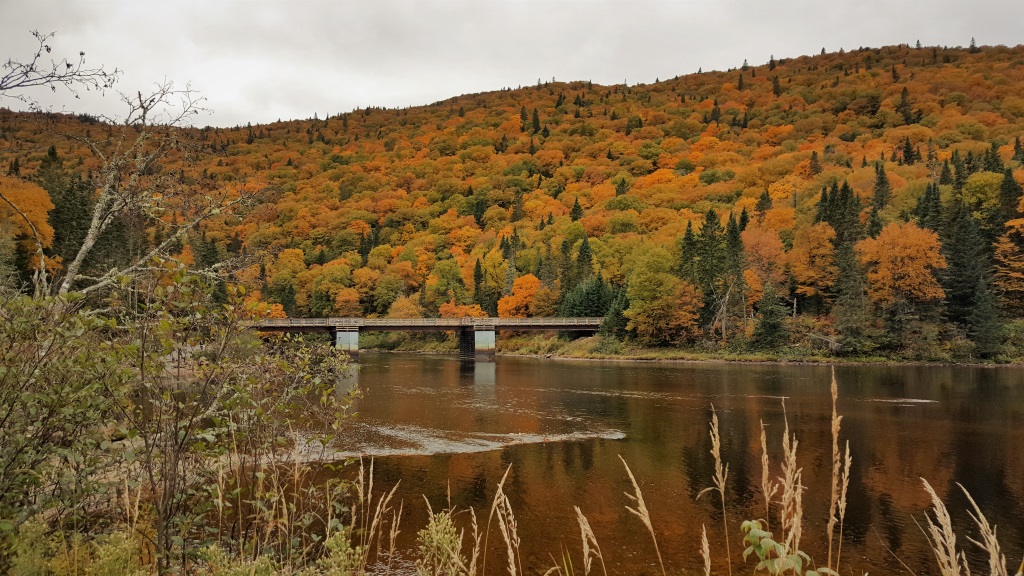
Jacques Cartier National Park’s stunning river valley is just thirty minutes away from Québec City. Amazingly close, but still too far to visit without a vehicle. We jumped at the local bus company’s offer of a special seasonal bus and visited on two consecutive weekends, right as autumn colors✨ peaked. The first trip revealed a valley over-saturated in yellows and golds, with almost all the leaves still clinging to the trees. It was breathtaking. We learned how the park’s very existence was a massive victory for environmentalists that protested the plan to build a massive hydroelectric dam and flood the valley in the 1970s. The fact that all this natural beauty was still around for us to share made us incredibly grateful✨. From the visitor’s center✨ we walked to L’Aperçu trailhead. This loop connected to the larger loop of Les Coulées and La Rivière-Sautauriski trails. A high point looked out across a yellow-and-orange valley✨ dotted with dark green pines. Making our way back downhill, we came across a porcupine✨ trudging along the trail. We followed the Sautauriski River✨ back toward the main road and another up-and-down path to the visitor’s center.
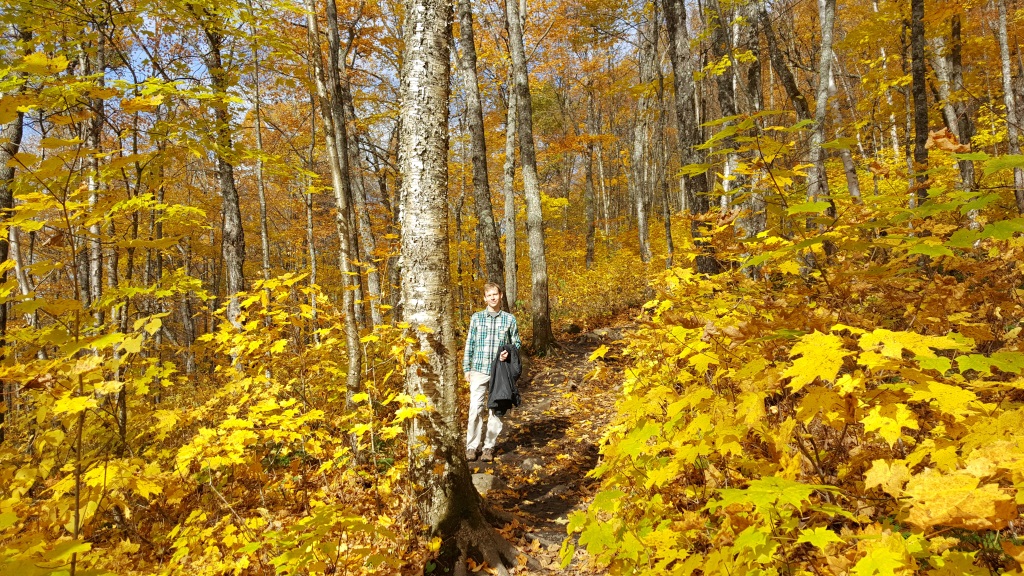
On another trip we hiked Les Loups which is, despite the name, a there-and-back trail. We reached it on the park’s internal shuttles and set out early in the day. This rocky and puddled trail switchbacked up hill to two separate viewpoints. The first looked over✨ the Jacques Cartier River valley✨, the Laurentian Mountains towering above. By now about half the leaves had dropped, but the ones that clung on still draped the valley in vivid color. The year’s baby squirrels✨ busied themselves trying to con snacks from hikers. Crystalline ice formations✨ grew in shadowy spots and crumbled at a touch. Viewpoint number two looked downriver✨ toward the park entrance, the glistening river surrounded by colorful trees. We passed far more people on the trek down✨. Rather than follow Les Loups path back to the parking lot, we turned on to the Maubèche trail✨. This also lead to a shuttle stop, but was far less used. We swished through ankle-deep leaves and met no one else on this section of path.

We also had a few chances for shorter hikes closer to home. Both sides of the St. Charles River have biking and walking paths✨ and plenty of parkland✨. It was the perfect place to stretch our legs and get a view of the city’s skyline✨ through reddening trees. A 40-minute bus ride from the city center, Montmorency Falls is another popular attraction, though less so in winter than in summer. We visited after one of the first large snowfalls. The paths were all slippery and the edges of the Montmorency River were beginning to grow fringes of ice. The city had roped off the lower viewing platforms✨ due to their ice coating, but the bridge✨ spanning the top of the falls was open. We could look directly down the drop even as chilly spray✨ dampened our faces.

Unfortunately, Québec’s Christmas Markets didn’t start until the day after we left (chalk up this disappointment to poor planning and a lack of research on our part). We saw the stalls and decorations✨ going up in downtown plazas✨ , but unlike in Zagreb, nothing opened a little early to give us a taste of what we’d be missing. But our stay wasn’t entirely without holiday festivities. Decorations went up throughout the city, shops started on their fanciful window displays, and we were lucky enough to catch the adorable Toy Parade. This short spectacle only had a dozen or so floats✨ and a few marching bands. It passed quickly enough that even littlest kids didn’t have time to lose interest. A pirate ship✨, cartoon characters, and a googly-eyed mailbox✨ all made an appearance. To our horror, so did the train that has been stalking us for some time now.
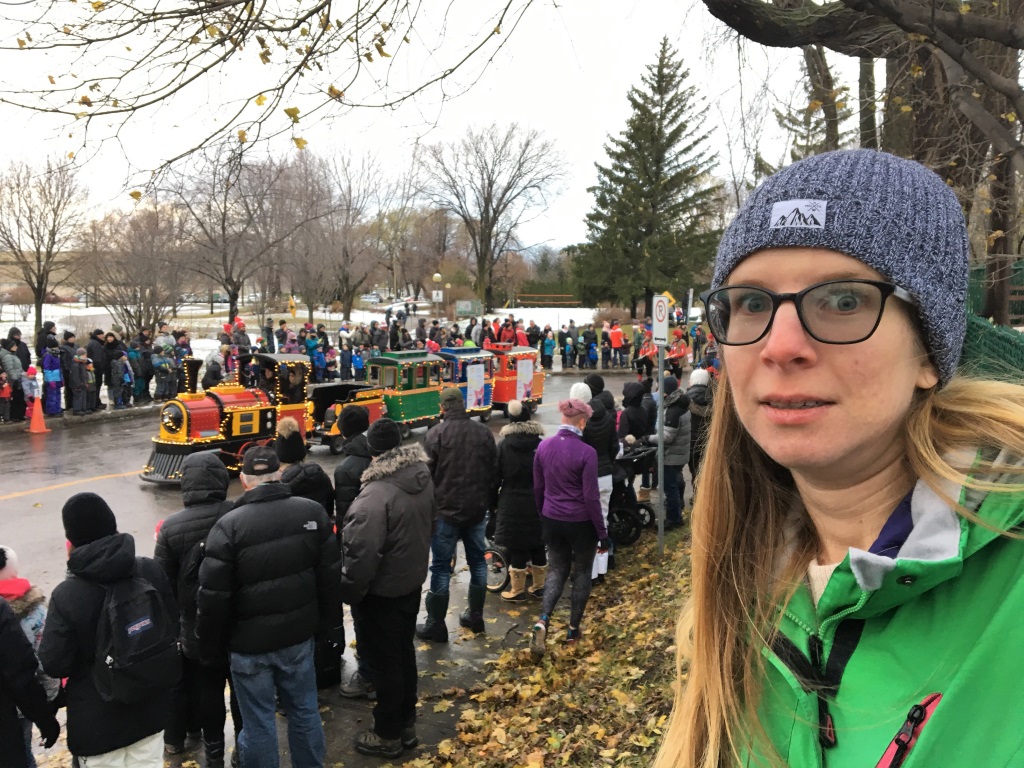
Food & Drink

Fall and winter weather and familiar selections✨ at the grocery store gave us just the excuse we needed to break out our favorite comfort food recipes. Most of our food shopping took place at supermarkets (IGA, Bonichoix) or the bigger, further-away Fleur de Lys mall (Maxi, Wal-Mart). For finer ingredients✨ and a stunning assortment of maple syrup products, we went down to the Old Port Market✨. This market offered a summation of each season – filled with smells of apples and cranberries in fall, squash and potatoes as the weather turned to winter.
The stereotypical image of Canada being the land of maple✨ turned out to be more gloriously true than we dreamed. In addition to the high-quality maple syrup, offerings of maple butter, maple candy, maple pastries, maple-infused sauces, and maple-flavored teas and baked goods filled the shelves. With pancake mixes and frozen waffles easily at hand for the first time in years, we had plenty of carbs to choose from when deciding on a sugar-water delivery vehicle.
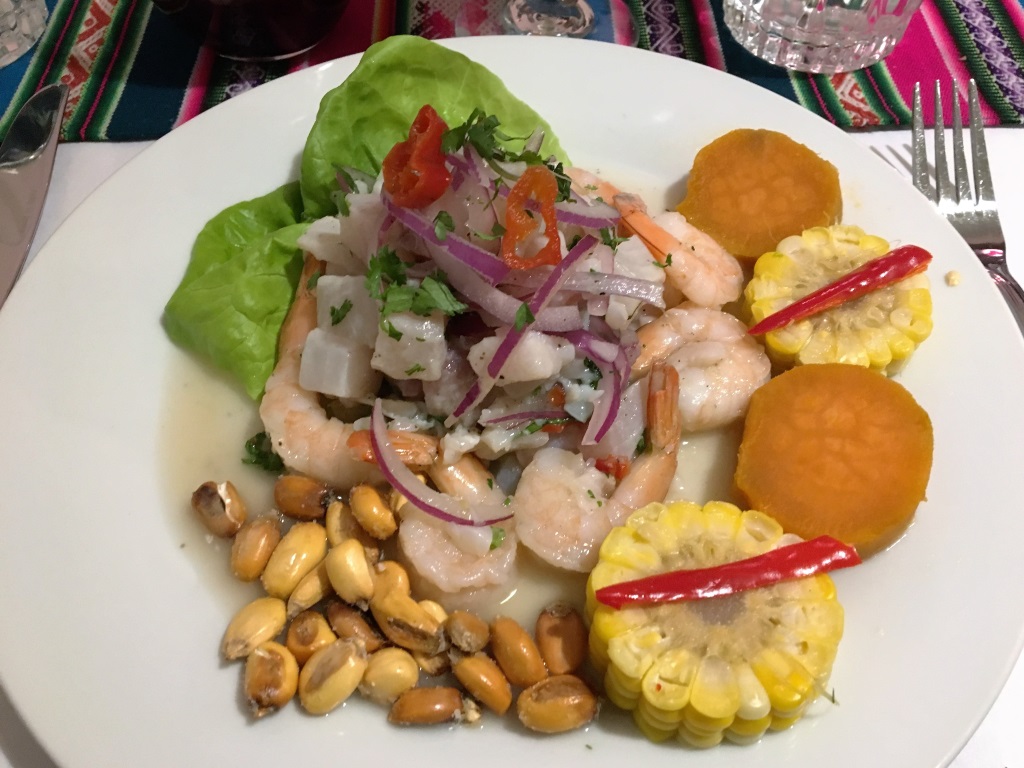
Québec’s cuisine blends French roots with North American ingredients. It is easy to find foie gras, fancy cheeses, and French wine, but also plenty of burgers, hotdogs, and French fries. But the few times we ate out were mostly about scratching the itch for international fare. El Ceviche🌐, a Peruvian restaurant near our second lodging, served up delicious ceviche and lomo saltado✨, and a pisco sour✨ with a twist of, what else, maple syrup.
Turkey✨ and duck were obvious choices for Canadian Thanksgiving – called Action de grâce (but rarely celebrated) in Francophone Canada. Other fall flavors were in full swing as well. Despite the kitsch, we actually enjoyed having the option to indulge in a gratuitous flurry of pumpkin spice✨ products.But the quintessential Québécois dish is of course poutine✨ – French fries doused with gravy and topped with cheese curds. We’ve been making our corrupted version, adding a bit of ground beef or whatever suited our fancy, for years. The original has thinner, chicken-based gravy✨ and features no added meats, though variations on the theme are accepted and commonplace. With a poutinerie on practically every corner and the essential ingredients in every grocery store, we were in a gravy-doused and cheese-studded heaven.
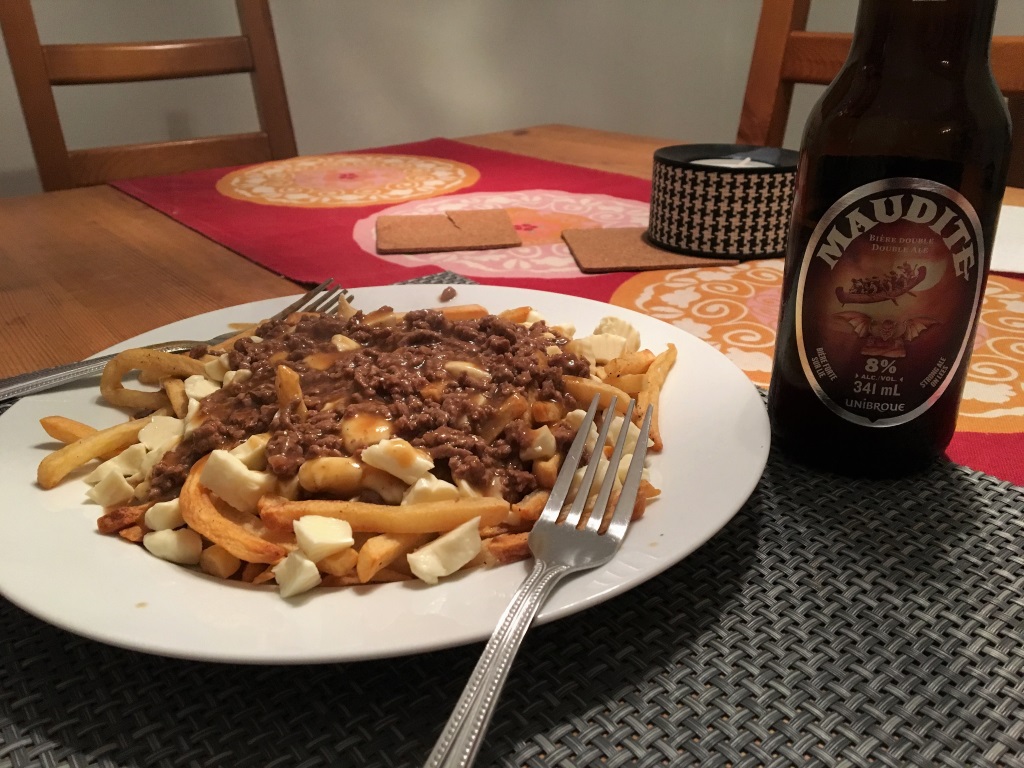
For snacking, All-Dressed chips are a uniquely Canadian invention combining all the best B-tier chip flavors – salt & vinegar, ketchup, and barbecue – into one, producing something better than the sum of its parts in the process. We also got to try all the brands we’d missed from across the pond like Fritos, Doritos, Cheetos, and Poptart-os. And, for the first time in ages, decent chocolate chip cookies.
Québec City had more than its fair share of good craft beer shops, from the obvious – The World of Beer🌐, The Duchess D’Aiguillon🌐 – to the unexpected (Alimentation Escompte L’Impact✨🌐). Beer was not cheap, however. Craft brews✨ often cost $4-5 a bottle or more. Much of what we sampled was good but underwhelming at those prices, especially after relatively recent stays in Poland and Lithuania. On the other hand, it was nice to finally have some seasonal✨ beers available for once. The on-tap selection at Brasserie Griendel🌐 was probably the best beer of our stay. We shared a sampler✨ that included À La Revoyure, a rye beer, and Vie Bonne, a dry hop sour, both of which were best-in-class.
Though quite far north, the province of Québec does produce some of its own wine, both red and white. But they also make lots of delicious hard ciders from apples and pears. We even saw wines derived from maple that sounded like a syrupy dessert, but were actually dry and complex. Canadian whiskey was also worth a sample, especially the craft distillers putting a new spin on traditional rye-based recipes. JP Wiser’s Hopped Whisky sounded like a good idea, but very much was not.

Getting around
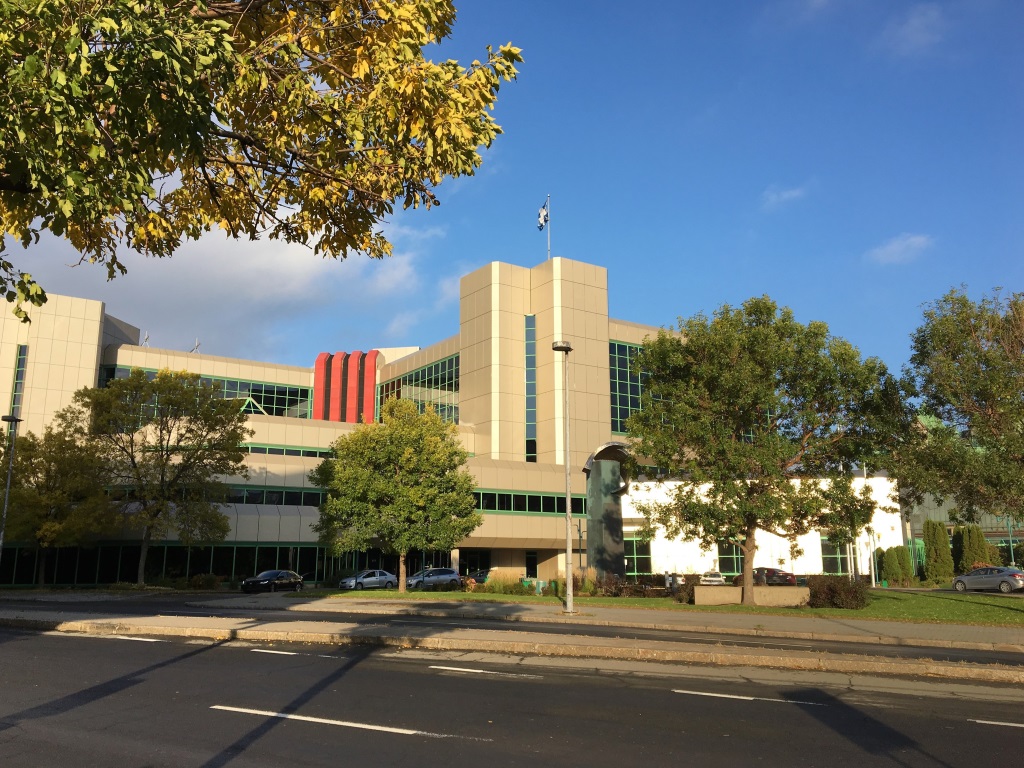
Québec was not too hard to reach from the US, though it did take a few steps. First we took a couple Amtrak trains✨ from our previous stop to Montréal for an overnight layover. Québec and Montréal are fairly close and well-connected by North American standards, but that still meant we had to spend upwards of $80 for roundtrip bus tickets between them (and don’t even ask about Via Rail, Canada’s subsidized-but-not-enough passenger train Crown corporation). Both cities’ bus stations are downtown, and Québec couples their bus and train stations together in a single sprawling complex.
It is certainly possible to get around central Québec City on foot, though that North American sprawl means the trips take longer than we were used to after a few years in dense European cities. A respectable bike lane network cedes the side of many streets to cyclists during the warmer months, but in winter, bikers beware. Road signs are pretty standard to the continent, but Québec also adds helpful diagrams✨ to stop signs to show which other directions do (or don’t) have to arrêt also.
Uber↗ is available and came in handy on a few occasions, though again, prices were fine by local standards but much higher than we had grown accustomed to.
For our trips to Jacques Cartier National Park, we took advantage of Intercar’s seasonal shuttles✨ for $25 per person per trip. The purpose-built route seemed like an experiment of theirs, testing whether people were interested in a public transit option for the peak of autumn colors. Buses ran once per day for a little over a week, linking a handful of downtown hotels with the visitor’s center. Despite the price it was a smashing success – the bus was packed on both our visits. We were happy to pay a slight premium for the convenience of not having to rent a car or deal with the park admission fee, and as far as nature is concerned a bit of carpooling is always appreciated.

Stuff of interest
Our AT&T SIMs came from the United States↗. The chips cost $5 each and a monthly plan covering calls, texts, and 8 gigs of data cost $50/month per person. Uniquely among American carriers, AT&T allows data roaming in Canada without limit (but within reason, presumably). Discounts for automatic billing and line sharing lower it to a combined $70 after the first month, but this is still incredibly expensive compared to the rest of the world. Nevertheless this was the best option we could find. Canada’s plans are somehow even more expensive.
Québec is famously, vigorously, defiantly Francophone. Canada’s dual-language laws guarantee French equal status alongside English, but in Québec French takes top billing (legally and figuratively). English is far from unheard of in the cities, especially in metropolitan Montréal, and several folks were happy to detect our difficulty and switch for us. But French is indeed the primary language of daily life. As usual, we learned a few key phrases to help us get by.
Beer and wine are easily available at many groceries and mini-marts (and Québec’s drinking age of 18 is a year less than most of Canada and several sooner than their neighbor to the south). But hard alcohol is another story. The province’s liquor monopoly maintains control of high-ABV drinks, selling them at SAQ stores or a few privileged vendors with special licenses. SAQ tended to also have a good wine selection and reasonable prices, so it works out well as long as an outlet is nearby.
On October 17, 2018, Canada officially legalized pot✨. It was a landmark day, accompanied by plenty of news coverage and conversation. We didn’t partake ourselves, though. Despite Québec’s reputation as a liberal and progressive province, they were dragged kicking and screaming to modernity on this one. Only a handful of SQDC shops (the cannabis-serving SAQ subsidiary) were opened across the entire province in time for “legalization day.” Nevertheless, judging by the amount of it we smelled around the city, individual citizens were more than happy with the change.
The exchange rate definitely was in our favor during our stay: $1 US bought us nearly $1.33 Canadian. The list prices were usually on par or a bit higher than back home, but after running the numbers, we definitely spent less than we would have in the States.
What we learned
Wow, winter✨ is really not for us. After nearly three years of chasing the summer – aside from short dalliances like Punta Arenas or Christmas in Germany – wintering (autumning?) in Canada was jumping straight into the deep end. And it was brutal. It’s not that we were wusses, or at least, that’s not the only factor. Sub-freezing weather is just not ideal for two travelers with limited bag space for layers and none at all for heavy jackets. But as long as we’ve no place to go? Let it snow, let it snow, let it snow!







